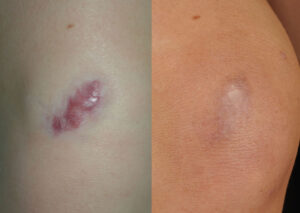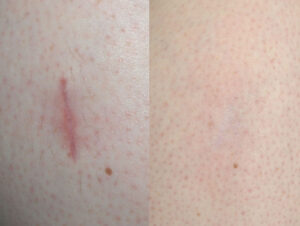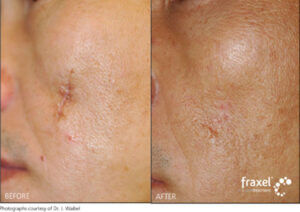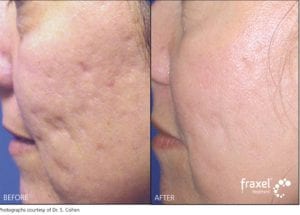Scars
 Scars occur when several layers of the skin are injured. Usually they occur as a result of injury, surgery or acne. The cosmetic problems from scars occur because they are red, white, depressed or raised (hypertrophic or keloid scars). As well as cosmetic concerns, some scars cause physical symptoms including itching, pain, and restriction of movement. Until recently very little could be done for scars, but in the last five years new developments, available from our dermatologist, have revolutionised the treatment options.
Scars occur when several layers of the skin are injured. Usually they occur as a result of injury, surgery or acne. The cosmetic problems from scars occur because they are red, white, depressed or raised (hypertrophic or keloid scars). As well as cosmetic concerns, some scars cause physical symptoms including itching, pain, and restriction of movement. Until recently very little could be done for scars, but in the last five years new developments, available from our dermatologist, have revolutionised the treatment options.
What scar treatment options are available?
A number of treatments are now available depending on the type of scar, and treatment may include a combination of different methods. Silicone gel or sheets can help mild or fresh scars. Creams and injections can help raised or itchy scars. Deeper scars can be removed by punch excision and rolling scars can be released by subcision. Depressed scars can be helped by prescription strength Vitamin A creams, chemical peels and dermal fillers such as hyaluronic acid.
Laser Treatment
Lasers can do much to improve the colour and texture of the scar and surrounding skin, and they have revolutionised the treatment of scars. Options include:
PicoWay® Laser
Although Picolasers were developed for tattoo removal and to treat pigmentation, it was noticed that at the sites where the Picolaser removed pigmentation, the skin quality had also improved. Following this observation, the PicoWay® has been developed with a fractionated mode (called Resolve) to improve skin quality including fine lines, wrinkles, pores and scars. One advantage is that there is relatively little recovery time compared to other fractionated lasers and it usually does not need local anaesthetic cream.
Following PicoWay® treatment, the skin looks slightly pink for 24-48 hours, but is not significantly swollen and any pinkness can usually be covered with makeup. Also, as it is a treatment to reduce pigmentation, it is less likely to cause darkening of the skin after the treatment, which can occur in patients with darker skin. Treatment of a full face takes approximately 15-20 minutes. It is also relatively comfortable, feeling like warm, but not painful, “sparklers” passing over the skin. This makes it a good treatment for busy people, teenagers or patients with darker skin. The treatment can be repeated every 10-14 days, as needed.
Pulse Dye Laser
A new technology for treating red scars is the pulse dye laser. This reduces the redness of scars and softens them. It is particularly good at removing the redness in fresh acne scars or surgical scars. Recent published research also shows that if a new surgical scar is treated with the pulse dye laser within a couple of weeks of stitch removal, the final scar is significantly fainter. The treatment is quick, almost painless and requires no special aftercare. The scar may be very slightly bruised for a few days afterwards, but this can be easily covered by makeup. The scar then becomes less red after a few weeks.
Fraxel® Laser
The latest exciting new technology for both depressed and raised scars is fractional technology or Fraxel®, patented at Harvard University in 2003. Fraxel® lasers use microscopically small beams of laser energy to treat 15-30% of the skin at a time. The islands of untreated skin stimulate the treated skin to heal rapidly and replace the damaged scarred collagen with normal fresh skin. This means that the healing time is much quicker. Two forms of Fraxel® are available.
Fraxel® Restore
Fraxel® Restore (using the 1550nm erbium glass wavelength). This is non-ablative i.e. it does not break the surface of the skin and therefore has a short recovery time but needs more treatment sessions. After treatment the skin may be red and slightly swollen and there is usually slight flaking of the skin a couple of days later. As the skin is not broken clients are usually able to return to work the next day (although if treatment is performed on the face, some may prefer to have at least one day off work afterwards in case their skin is slightly swollen). Make-up can be applied the next day which usually covers any redness. When Fraxel® Restore was launched in 2003 it revolutionised the treatment of scars. It is done using local anaesthetic cream. Fraxel® Restore (sometimes combined with pulse dye laser) is our most frequently chosen scar treatment as clients can often return to daily activities straight away. It can be safely used on skin of all colour (from very fair to very dark).
Fraxel® Repair
Fraxel® Repair (using the carbon dioxide or CO2 wavelength). This micro-ablates the skin i.e. it removes microscopic tubules of skin and creates heat in the skin so that as the skin heals it tightens. It is done using local anaesthetic cream and sometimes additional anaesthetic injections. A few day’s recovery and careful skin care is needed, but the tiny size of the tubules removed means the skin heals significantly more quickly and safely than traditional total resurfacing CO2 laser which previously required a couple of weeks’ recovery and a general anaesthetic. The Fraxel® Repair (CO2) is a very effective treatment for scars, wrinkles, sagging and crepe-like skin, stretch marks and abnormal skin texture. One treatment with Fraxel® Repair is approximately equivalent to three treatments with the Fraxel® Restore.
Dr Farrell was one of the first consultant dermatologists in the UK to have purchased the Fraxel® Repair and has trained with some of the earliest experts of this exciting laser in the USA.
The most appropriate treatment can be chosen according to the individual’s clinical need.





